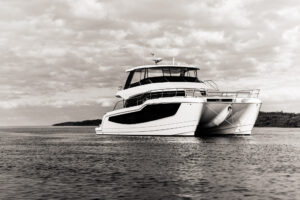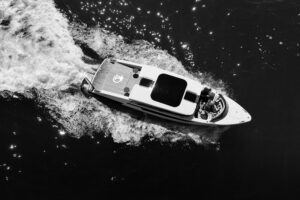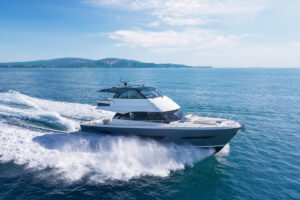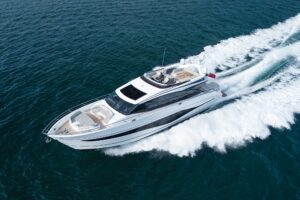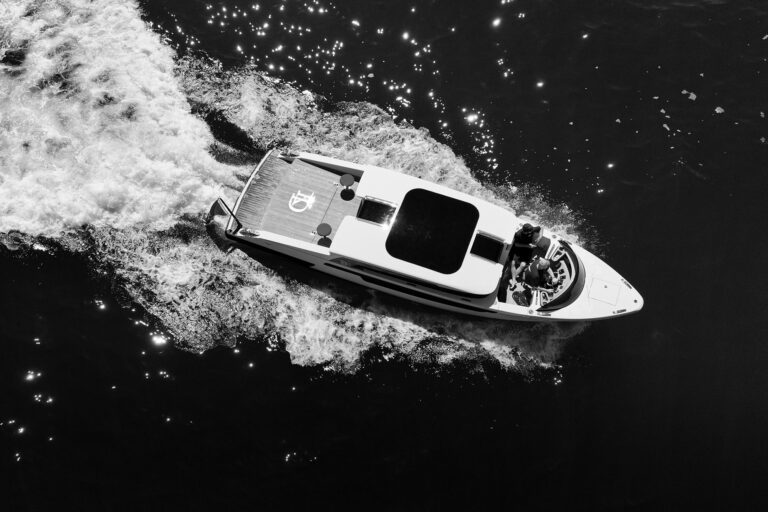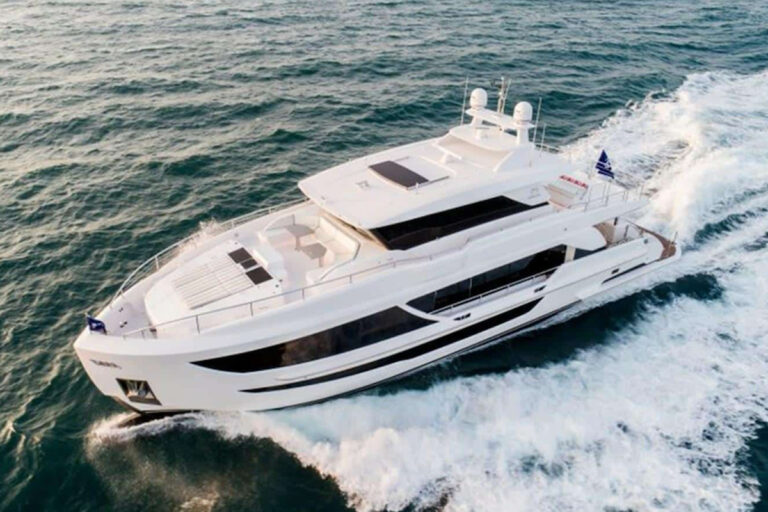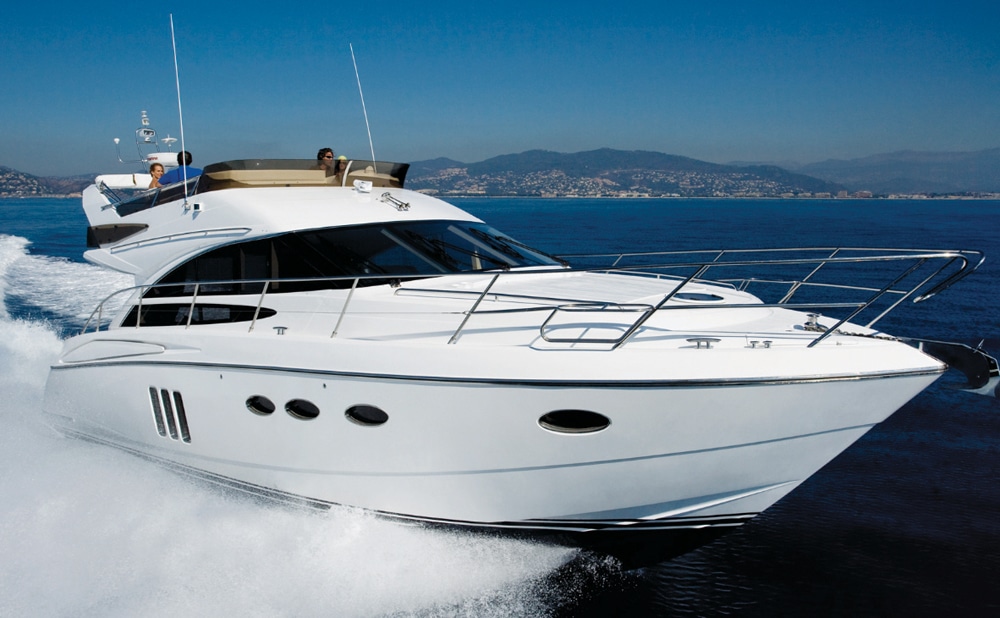
Viking Sport Cruisers Princess 50
“Stop the presses!” I always wanted to shout this phrase, although now that computers and electronic wizardry have shanghaied the printing process, it’s more like “please gently remove your finger from the send button.”
What’s the breaking news? Viking Sport Cruisers, built in Plymouth, England, by Princess Yachts, is now going to be carrying the name of the builder. So, what was the Viking 50 Sport Cruisers a few days before this writing is now the Princess 50. The move is purely an effort to build a more global, less-fragmented brand structure by Princess’s parent company, luxury-goods powerhouse LVMH (owners of Louis Vuitton, De Beers, and the Feadship Yacht brand, among others).
What’s this going to mean to the boater looking for the well-designed, sound performance cruiser for family adventures previously offered by Viking Sport Cruisers? Well, not a whole hell of a lot. As with all of her sisterships, Princess incorporates design and equipment direction from Viking Sport Cruisers, now the distributor for Princess in the Americas.
I still maintain that the concept of importing Princess models into the Americas under the Viking Sport Cruisers moniker 15 years ago, and ensuring they would satisfy the demands of the New Jersey builder, was brilliant business. Had the boats simply arrived on these shores, as is, with zero changes and relatively unknown, they would have been about as welcome as Tony Hayward at a Bayou crawfish boil. Have other European builders tried this? Sure, and some have been successful, others not so much.
However, the Viking Sport Cruisers philosophy went beyond the initial sale, and zeroed in on the after-sales process. They were able to capitalize on an impressive dealer network that already serviced the fishing-oriented Viking Yachts. They ensured that equipment used on each model could be easily serviced in North and South America. And some design tweaks were incorporated to reflect how boats are actually used on this side of the Atlantic. “The major change is the name on the side of the boat,” explains James Nobel, marketing director for Viking Sport Cruisers. “The hull identification number will remain VSC [Viking Sport Cruisers] and we’re still focused on Princess, with a Viking difference.”
So, American boaters, meet the Princess 50—the latest generation of this model. Compared to the previous 50, this is an entirely new hull, and the interior benefits from a 15-foot, 3-inch beam. To really appreciate the interior design, volume, and clever touches of the 50, you need to place it in context. Even consider comparing it to the previous 50, and it is patently obvious that areas such as the master stateroom have leapfrogged the design evolution process. The master stateroom spans the full beam, and features six large hullside windows, allowing streams of light and air into the master stateroom.
“The market was really demanding a full-beam stateroom,” commented Nobel, as we toured the boat in Plymouth. Yet, to carry it off correctly on a 50-footer is usually tough, and you often end up with a space better suited as a nursery than as one for two adults.
Two additional staterooms are forward. The forepeak guest stateroom is equal to what was the master stateroom on the previous 50, and shares a head with the starboard, twin-bunk stateroom. The well-equipped galley is to port on this level, offset from the passageway. Loads of stowage and cleverly designed drawers will hold provisions for extended cruises.
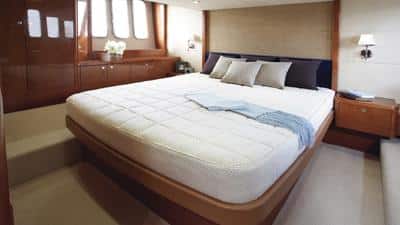
A few steps above, the double helm station is an area that I believe Princess has perfected. The line of sight, even while cruising along at 25 knots and banking into turns, is flawless. The analog gauges are easily viewed—no neck-twisting necessary. Our test boat was equipped with a Furuno NavNet 3D chart plotter and radar combo on the inboard side of the helm station. When extra vigilance is required, such as running in fog or at night, this arrangement works really well. The mate can push the buttons and navigate, while giving the helmsman direction. And again, because the line of sight is unobscured, running at night from the station is an easy option. The engine controls, bow thruster stick, and necessary breakers are all perfectly placed for a natural orientation.
There is a dinette opposite the helm station. I like having a designated “dining” area and a designated “lounge” area. If you cruise with kids or grandkids, you know that meal times are often staggered. Without this setup, chances are you’re prematurely converting the saloon into a mess hall for mac and cheese and chicken nuggets, while the adults are still trying to relax. Because of the large windshield, it’s also a good perch for your guests to sit and watch the action if the captain chooses to operate the 50 from the lower station.
A U-shaped settee runs the length of the starboard side in the saloon, with a banquet and f latscreen TV opposite. In the saloon, as in the rest of the interior, the joinery is flawlessly executed and finished. Princess offers several choices of wood, depending upon your taste.
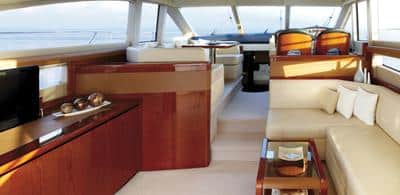
Another noticeable improvement over the previous 50 is in the engineroom. Some key service points on the earlier model required a gymnastics routine to access. Not so on the latest version. There is sufficient room around the twin 670-horsepower Volvo D11 diesels for routine service, with access from a deck hatch.
The deep-V hull with 19-degree transom deadrise produced a ride that I’ve come to expect from Princess. The 50 greeted the three-foot chop, mixed in with a larger swell f lowing in from the English Channel, with a mocking laugh. There was no protest from the hull structure when we met the seas at a top speed of 32 knots. Her running attitude was at approximately five degrees, which just added to the aforementioned flawless line of sight from the lower station. Optional 715-horsepower Cat diesels are offered, giving a top speed of 32.4 knots—as well as a few more knots and a few more miles of range when comparing engine load data in the 80- to 90-percent range.
The flying bridge helm is to port, and when backing down, the helmsman can easily see astern by looking through the staircase opening and transom door. There’s a drink fridge and barbecue abaft the helm, and a settee with a table along the starboard side. Tender stowage is relegated to the large swim platform, which is preferable in my opinion.
Anchor retrieval is made safer with a horizontal deck platform and a grippy non-skid around the windlass.
Princess Yachts offers models ranging from 42 to 130 feet. The yard’s hightech, 38-acre facility is continuing to build high-quality boats that are constantly evolving as technology and market preferences evolve. The new 50 is a sound example of this equation. Combine this with the dedication and expertise of Viking Sport Cruisers, along with their strong dealer network, and you may find yourself humming the same line I have while writing this review: “Meet the new boss, same as the old boss.” If you’re looking to create some family adventures, the Viking… err…Princess 50 is ready for the task.
LOA: 49’5″
Beam: 15’3″
Draft: 3’2″
Displ.: 41,890 lb.
Fuel: 600 gal.
Water: 155 gal.
Deadrise: 19 degrees
Standard Power: 2 x 670-hp Volvo D11 diesels
Optional Power: 2 x 715-hp Caterpillar C12 diesels**
Base Price:** Price is available upon request
Viking Sport Cruisers; (609) 296-6000, www.vikingsportcruisers.com

